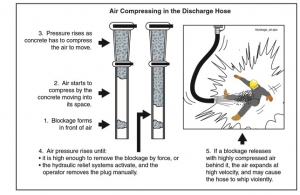SAFETY BULLETIN
Hose Whipping
How to avoid injury by a hose whipping from compressed
Purpose
The purpose of this is to highlight the hazards and risks to workers and other persons caused by the hose whip on concrete pumps. Understanding why hose whip occurs and measures to prevent injury will ensure a safety work environment
“Hose whip” is described as uncontrolled and random rapid motion of the flexible rubber hose at the end of the concrete delivery system.
Background
Hose whipping accidents are one of the most common accidents associated with the operation of a concrete pump. Air trapped in the delivery system is a common cause of hose whippings. Air can be introduced into the delivery system by various means. However air in the delivery system by itself poses no particular hazard. It’s only when the air is compressed thereby storing energy that a hazard is created. This trapped air is momentarily compressed and then release randomly causing the hose to whip violently.
Contributing Factors
A hose whip can occur during the concrete pumping operation itself or when the concrete delivery line (pipes) is being cleaned out. The hose can whip uncontrollably when airs enter the pipeline and become pressurized by the pumping process.
Personnel’s can either be injured as a result of being struck directly or being knocked over and hitting the ground or an object.
The likelihood of hose whip can be reduced by the selection of suitable pumping systems and safe system of work. While the risk of hose whip can be reduced, additional precautions need to tbe taken to reduce the likelihood of injury.
Preventive measures to minimize the likelihood of injury.
- Only pump concrete that is of a pump able mix. Other mixes of concrete can block the pipeline and cause hose whip.
- Start the pump slowly to reduce the likelihood of hose whip
- Do not let the concrete solidify in the pipeline as this will cause blockages. The concrete need to remain in its plastic state.
- The delivery hose on the boom pump should hang close to vertical and only be guided by the placing crew. If the boom is not long enough to reach the concrete pour area, a larger boom should be used or the pump car should be moved closer to the job.
- Do not allow concrete to drop out of the hose when pumping operation is stopped, as this can allow air to enter the system. The hose can be folded over to prevent concrete from dropping out.
- Always ensure that the placing crew has an adequate size area to stand on (The width of the working area should be at least 450 mm or greater) the line hand (Personnel guiding the end hose) should not stand on block walls or next to unprotected edges.
- Monitor the level of concrete in the hopper to avoid air getting sucked into the pump system. Make sure that the hopper still contains concrete before pumping operations has ceased.
- Never try to stretch the delivery hose if it does not reach the pouring location.
- Make sure work safe procedures are adopted for clearing blockages.
- When cleaning the pipeline, secure the end of the steel pipeline and have an exclusion zone (No personnel to enter the zone). All reducers and the rubber hose must be removed from the end of the delivery line. A ball catchers should be fitted to the end of the steel pipe. This will contain the blow out plug as it is ejected from the line.
Every person in the chain of the pumping operations has a responsibility to help protect the hose person and other nearby personnel from hose whipping accidents. Education and knowledge is the key, followed close by alertness and diligence as well as personal protective equipment.
Everyone must be aware of the communication procedures between all parties involved in the pumping operation. Communication is key to minimize any hose whipping incidents.
Ensure that there is adequate training and everyone is aware of the safety procedures involved in the pumping operation.



